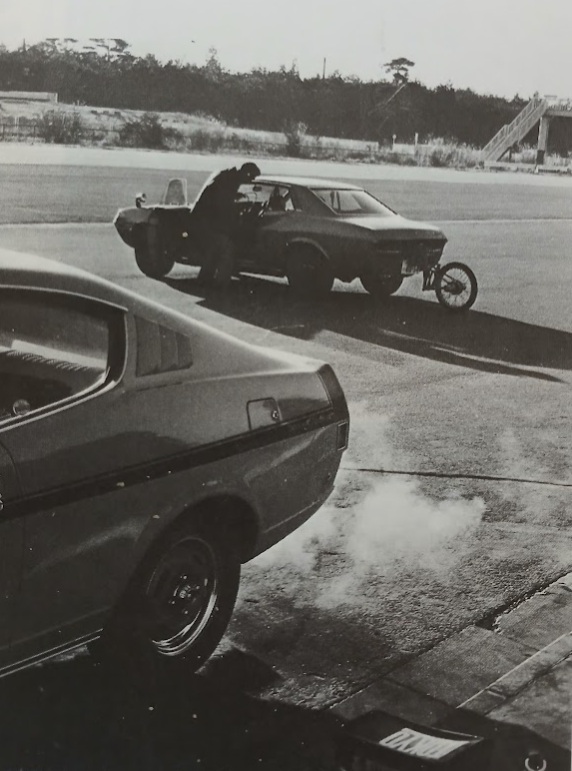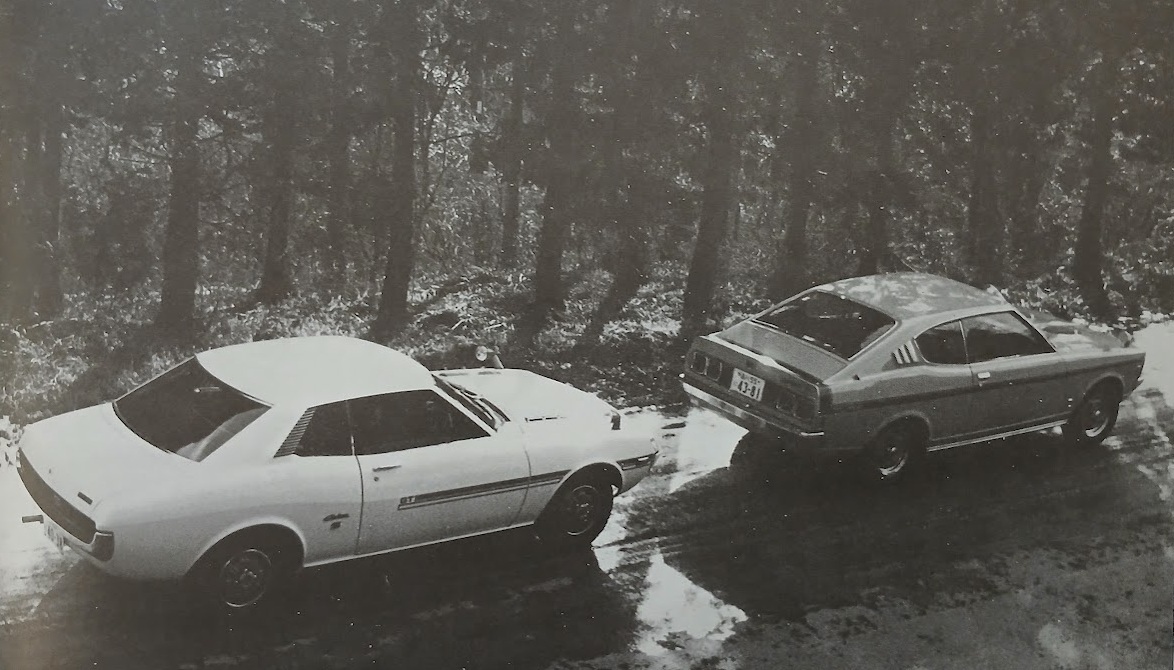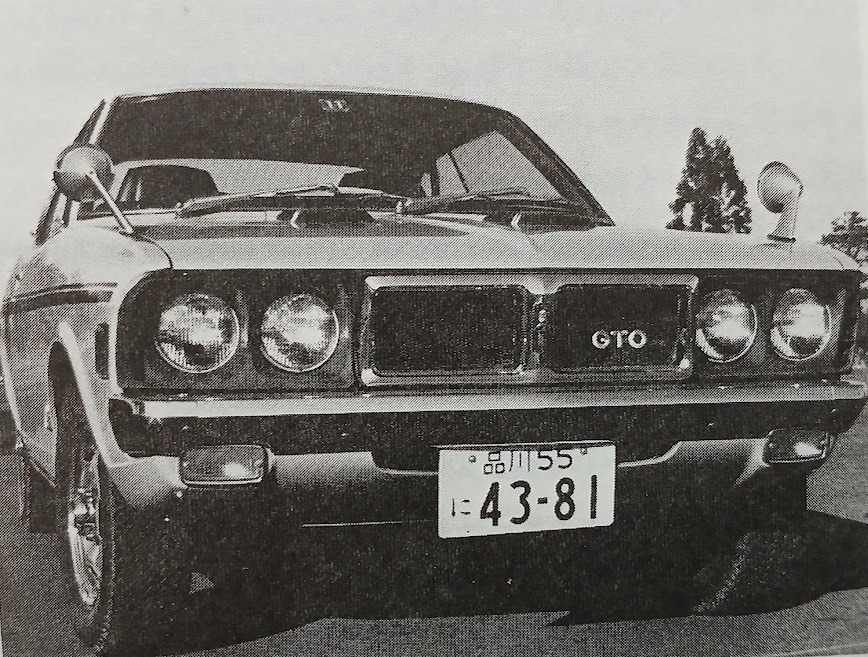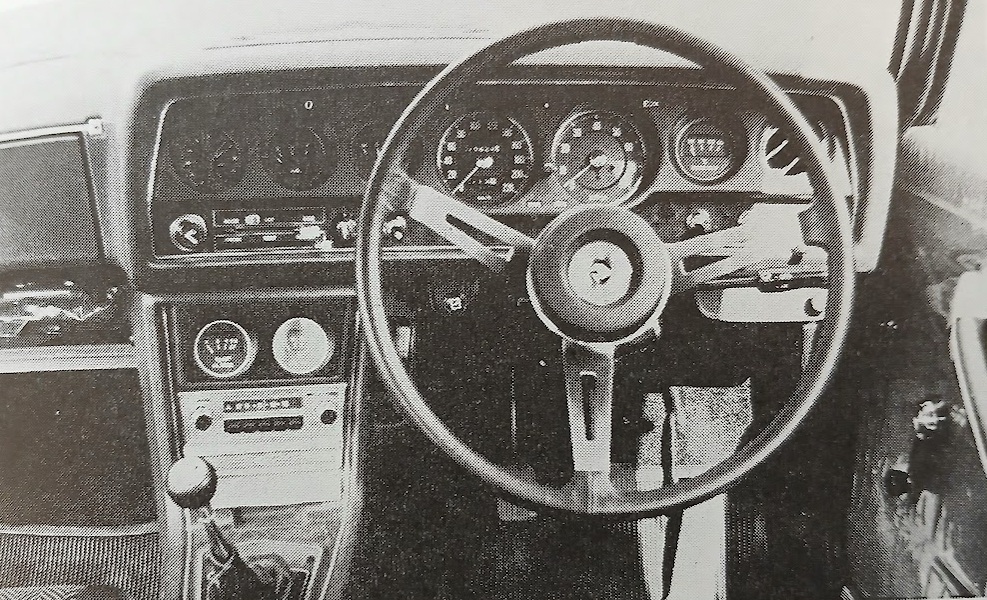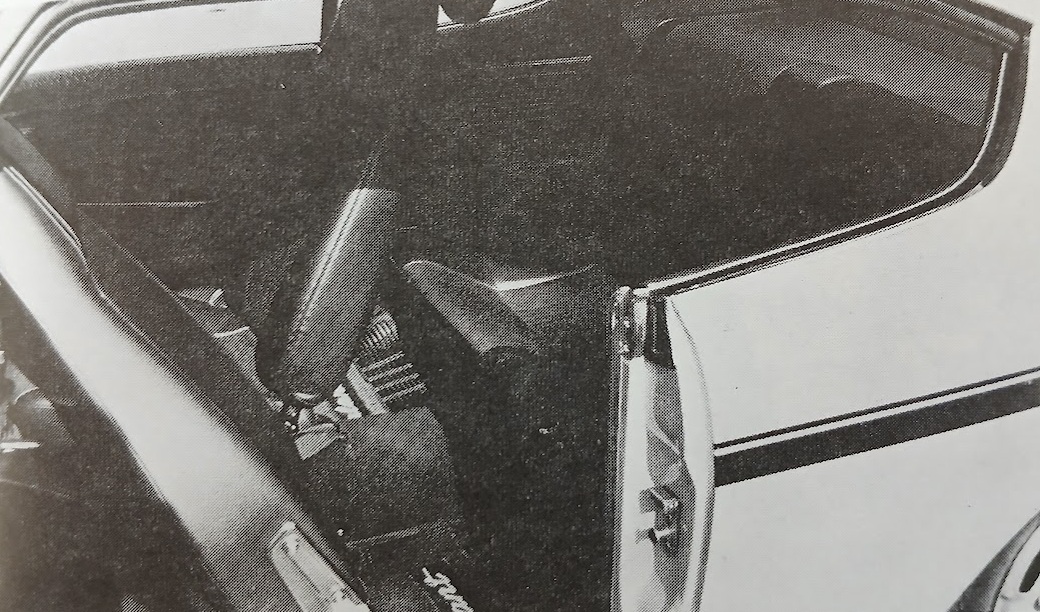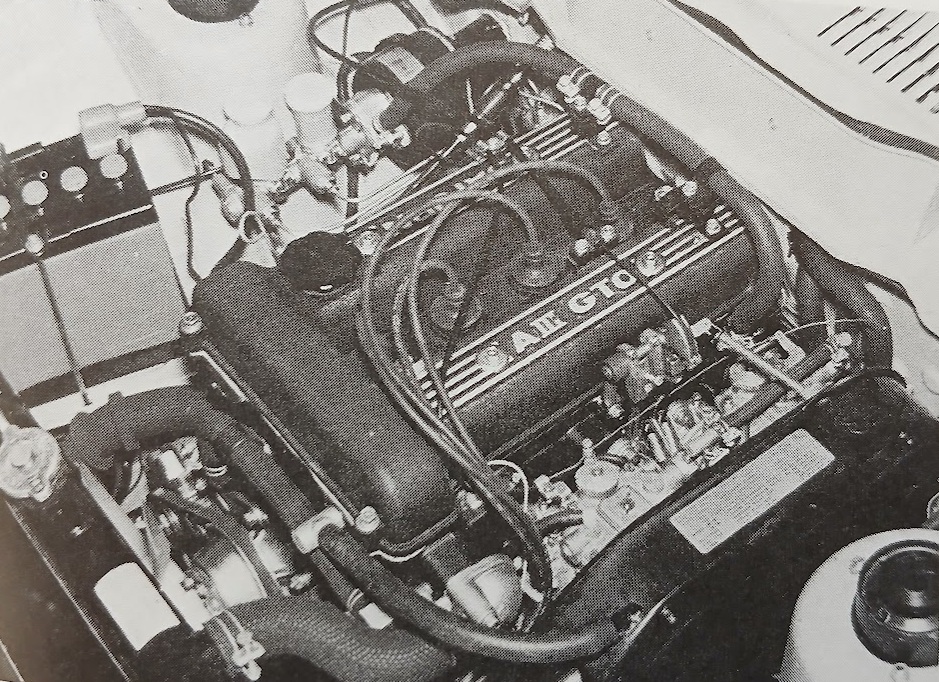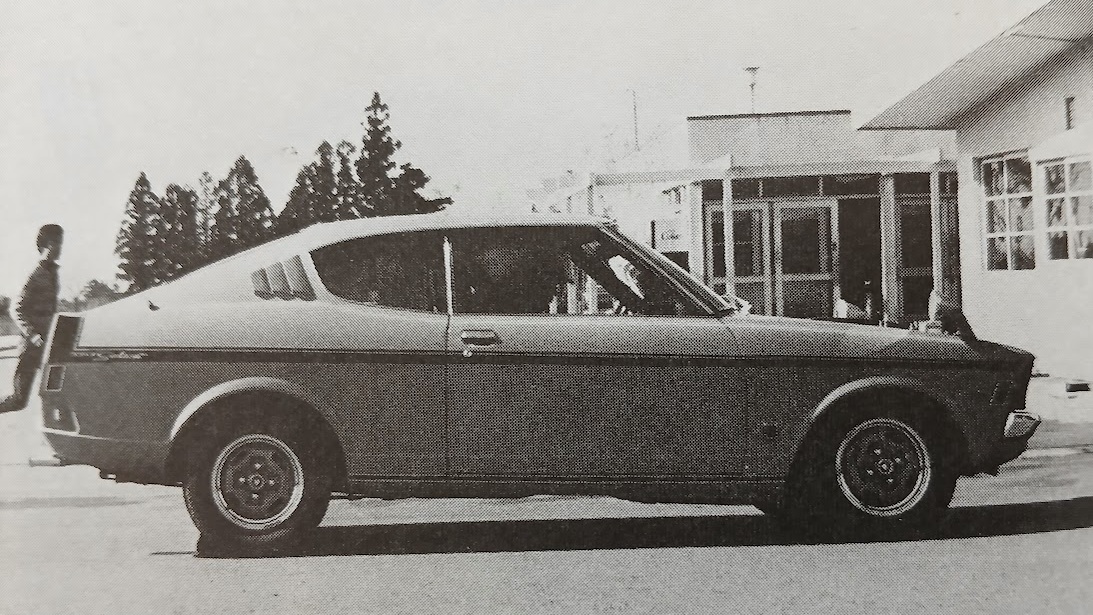Mitsubishi Colt Galant GTO MR vs. Toyota Celica 1600GT (1971)
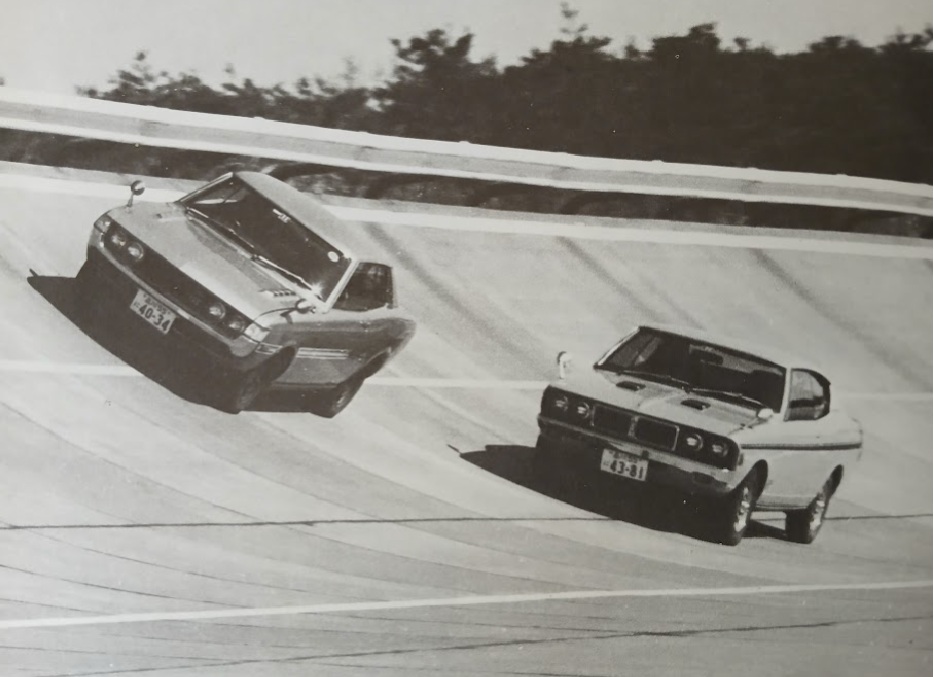
Publication: Car Graphic
Format: Group Test
Date: April 1971
Author: “C/G Test Group” (Shotaro Kobayashi, uncredited)
Comparison test: Mitsubishi Galant GTO MR vs. Toyota Celica 1600GT
Mitsubishi’s Galant GTO MR and Toyota’s Celica GT are very similar in both specifications and character, and are five-seater sports coupes that appeared at roughly the same time, targeting the same market. Both are equipped with 1.6-liter DOHC engines and 5-speed gearboxes, and there is almost no difference between them in terms of external dimensions or weight. Structurally, both cars are very orthodox, with a monocoque hardtop body based on the chassis of a mass-market sedan (the GTO is based on the Galant AI/AII, the Celica on the Carina). Both have a conventional layout with MacPherson strut front suspensions and rigid axles at the rear, but the rear suspensions differ in design; the GTO series is leaf-sprung, and only the most powerful MR model has a torque rod added, while the Celica’s is suspended by coil springs, with four longitudinal links and lateral location via a Panhard rod.
The DOHC engines are similar, with an oversquare bore and stroke of 85mm x 70mm for the Celica and a long-stroke 77mm x 86mm for the GTO, a rarity these days. The compression ratio is 9.8 for the Celica and 9.5 for the GTO. Both cars have twin Mikuni Solex double-choke carburetors, and both require super-grade fuel. The outputs are 115ps/6400rpm and 125ps/6800, with the GTO slightly ahead, but the maximum torque is 14.5kgm for both. However, the power-to-weight ratios are 8.2kg/ps and 7.8kg/ps, giving the GTO a slight advantage. The wheel and tire sizes are the same for both cars, with 4.5J rims and 165-width tires, but the test Celica was fitted with Bridgestone Radial 20 165HR-13s, while the GTO had Yokohama GT Special 165SR-13s, with the former featuring a Class 1 high-speed specification. While there are many similarities between these cars, there is a big difference in price, with the GTO priced at 1,125,000 yen. By contrast, the Celica costs 875,000 yen, which hints at the difference in the two manufacturers’ manufacturing and sales power.
Power performance
The Celica GT’s DOHC 115ps unit is a standout among Toyota engines. From its smooth idle of about 800rpm to the beginning of the redline at 7000rpm, it revs incredibly smoothly, with almost no vibration being transmitted to the body even at high speeds. At around 4000rpm, the exhaust resonates through the cabin a little, but the mechanical noise is exceptionally low for a twin cam. The top speed at Yatabe was 176.8km/h (measured on the 1km straight), which corresponds to 5900rpm in fifth gear. Evidence of the relatively ample power is shown by the fact that even in direct fourth gear, it reliably achieved 173.8km/h, with the revs at 6750rpm, slightly higher than the power peak of 6400rpm, but still within the yellow zone.
The gear ratios of the 5-speed gearbox are appropriately set for the power and weight. In first, second, and third gears, if you wind the engine to 7000rpm, it will reach 51, 91, and 134km/h, respectively. On the other hand, this engine has good tenacity even at low and medium speeds, and can maintain 2000rpm on a gentle uphill gradient. Surprisingly, the overdrive fifth gear can be used from as low as 60km/h if you feel like it, but of course it is meant to be an economical cruising gear for highway driving at 100km/h or more. To illustrate this, 100km/h is about 3800rpm in fourth gear, but when you put it in fifth gear, it drops to 3100rpm, and the noise level becomes even quieter. Gear whine from the fifth gear is almost inaudible. The 5-speed shift pattern is the same as that of the Fiat 124 Coupe, with fifth gear to the upper right, and gear lever operation is smooth and accurate, so you’re unlikely to accidentally shift into fifth when shifting up from second to third gear.
Acceleration is undoubtedly fast for a 1.6-liter practical car. 0-400m is achieved in 16.8 seconds, and 0-1000m in 32.0 seconds, which is significantly faster than the previously tested Carina 1600ST sedan with a SOHC 105ps engine and 5-speed gearbox (17.9 seconds from 0-400m), and clearly shows the power of the DOHC (although the Carina was also a brand-new car, while this Celica was well run-in with about 2,100km).
The first thing to note about our GTO MR is that this was a test car with about 11,000km of hard use on the odometer. The engine was not in perfect condition, and the all-important top end power seemed a little below par. In low gears it easily revved over 7000rpm, but in fourth and fifth gears it topped out at only 6500 and 6050rpm, respectively, and if it went any further it seemed like the ignition was cutting out. As a result, the average speed on the 1km straight at Yatabe was only 182.0km/h, which was significantly lower than the catalog data (200km/h). However, for a 1.6-liter practical car, this performance is still extremely good, faster than the 180km/h of the Fiat 124 Coupe (1608cc) and close to the 185km/h of the Alfa Romeo GTV (1570cc). Despite its long stroke, the engine revs well, and in low gears it winds up to the redline of 7200-8000rpm without any hesitation. However, compared to the Celica, the mechanical noise was generally louder, and the exhaust resonance was harsh, especially at 4000rpm.
The shift action of the 5-speed gearbox was even better than that of the Celica, with shorter throws and a very pleasant feel. The shift pattern was also the same, with fifth gear at the upper right. The top three gears were closer together than in the Celica, and third gear in particular was closer to the direct fourth gear in the GTO, with a third-gear ratio of 1.273 versus the Celica’s 1.384, and it reached 145km/h in third at the start of the redline at 7200rpm.
Maximum torque is the same as the Celica at 14.5kgm, but mid-range torque was generally stronger than that of the Celica. As the data shows, for example, 80-120km/h in fourth gear was significantly faster, at 8.9 seconds for the GTO compared to 10.4 seconds for the Celica. The GTO also accelerated from 0-400m in 16.3 seconds, 0.5 seconds faster than the Celica’s 16.8, but the 0-1000m time was 31.2 seconds, which was not as good as expected. This was probably because, as mentioned above, the GTO’s engine was slightly out of tune at the top end. In general, there was always power to spare, and even on the uphill slope around Matsuda on the Tomei Expressway, it was easy to maintain 80km/h in fifth gear. The third gear, which can extend from just 30km/h to 145km/h, was extremely versatile, and when we were stuck behind a slow car on the highway and needed to overtake, we would usually skip a gear from fifth down to third and stay in third throughout the maneuver.
The power of third gear was clearly demonstrated in an incident that occurred during the test. Specifically, during the test at Yatabe, the Celica’s clutch expired (fortunately right after all the measurements were finished), and we used the GTO to tow the Celica back to Tokyo, driving about 80km at 50-60km/h in third gear. Even with this heavy load, the GTO’s water temperature remained at normal levels.
Comparing the two cars in terms of power performance, the data shows that the GTO is slightly better, but in actual driving, our impression was that there is almost no difference. If we had to say, the Celica’s engine has a range where the torque curve flattens out around 3000 to 4000rpm, while the GTO’s is broader, so it could be said that the GTO has a slight advantage when accelerating out of corners. Incidentally, when comparing these two cars to the Fiat 124 Coupe 1600 and Alfa Romeo Giulia GTV, which have similar specifications, the top speeds are 180km/h for the Fiat and 185km/h for the Alfa, and the 0-400m times are 17.8 seconds and 17.7 seconds, respectively. Putting aside the top speeds, the two domestic cars are much faster in terms of acceleration.
Fuel efficiency
In the constant speed fuel consumption test, measured at 100km/h on a completely flat 1km section at Yatabe, the Celica was better, at 13.1km/l in fourth gear and 13.9km/h in fifth gear. This is understandable because the output is 10ps less than the GTO, the weight is 40kg lighter, and the gearing is slightly taller. Under the same conditions, the GTO recorded 11.3km/l and 12.3km/l.
However, the situation was reversed when the two cars were driven in a convoy for about 550km on regular roads, with the Celica getting 7.4kml and the GTO 7.7km/l. This is the average value for the outbound trip to Yatabe (and excludes the return trip, where, as mentioned above, the GTO towed the Celica) and the high-speed run on the Tomei Expressway to Hakone. This suggests that the GTO is slightly superior in terms of real-world power performance, and in order to keep up with the GTO’s fast pace, the Celica had to make more frequent use of high revolutions in low gears. Both cars needed to use high-octane fuel, and the tank capacity was 50 liters for the Celica and 55 liters for the GTO, so a safe cruising range for both could be said to be 350km. The results of the CO2 test showed that the Celica measured 5-5.8%, while the GTO returned 8%, completely failing that particular test.
Handling, ride comfort, and brakes
The day after the Celica and Carina were announced, when we drove the new cars at their release, we noted that the steering response was unusually sharp for a Toyota model (especially the Carina with its Bridgestone Radial 10 tires). However, based on our impressions after testing the Celica for about 2,000km, we have to revise our opinion slightly. It is still quite responsive, but compared to European cars in the same class, such as the Fiat 124 or Alfa, it is sluggish, and it felt as if rubber in the linkage had to be twisted about 5cm before the steering actually started to work. The test car’s Bridgestone Radial 20s are softer on the road than the Radial 10, and there was almost no kickback, but they were a little less responsive and they squealed easily.
The Celica’s rear axle, suspended by a four-link system, had good grip even in tight corners, but the body rolled a little too much. The handling is of course not bad, but it is not particularly outstanding either, and for our tastes it has a little too much understeer.
When we drove the car at its release, we had the impression that the ride was unusually stiff for a Toyota product, but that was probably because the friction in each part was still very much in effect when it was new, and this time it seemed to have an appropriate ride on all road surfaces.
The servo for the disc/drum brakes is quite powerful, and even with a pedal pressure of 20kg, it exerted a braking force of 0.78g, and with 40kg it was possible to obtain a maximum braking force of almost 0.95g. However, there was a lot of nose dive. In the 0-100-0 test, the pedal force increased from 16kg on the first stop 26kg by the tenth stop, a 60% increase that is within the normal range.
The steering of the GTO MR, with 4.5J rims and 165SR-13 Yokohama GT Special tires, is much more precise and responsive than that of the 4J-equipped GTO MII we tested previously. Even with the same tires, the MII had a lot of tire squeal in corners and was difficult to keep on course, but the MR was much more stable. The car has little roll, understeer is well controlled, and it responds quickly to even the slightest steering movement. On the other hand, the steering force required for parking is disproportionately heavy given the car’s weight.
The torque rod attached to the rear axle has a remarkable effect, and the GTO MR does not experience any rear axle tramp during sudden acceleration, which was particularly bad in the previously-tested Galant AII GS. Instead, the car accelerates decisively with slight wheelspin. Similarly, when accelerating out of a tight corner on an uneven road surface, the power is transmitted to the pavement without any waste. The cornering is extremely stable, and even if you release the throttle in a high-speed bend, it has almost no effect on the car’s course, and only slightly weakens the understeer. This is a car that can fly confidently on winding roads.
When we tested the GTO MII, we found its ride noticeably rough, especially at low speeds, but strangely enough, this was not an issue with the MR. Of course, it is on the stiffer side in absolute terms, but it is firm, not harsh.
The servo of the disc/drum brakes was weaker than that of the Celica, and required a heavier pedal force. For example, only 0.5g of braking force was obtained with a pedal force of 20kg, and a heavy foot of nearly 50kg was required for maximum braking force. Fade resistance was also weaker than that of the Celica, and in the 0-100-0 test, 40kg of force was required for the tenth stop, twice as much as the first.
Comparing the two cars, the GTO’s handling is closer to that of a sports car. The Celica driver has to make a considerable effort to keep up with the GTO as it speeds down a winding road, but on the flip side, the Celica offers a more comfortable ride and the overall feeling is more refined.
Interior and equipment
Both cars’ front seats are fully reclining with integrated headrests, and are extremely comfortable. There is not much difference in the driving position, but the Celica has a higher cowl (or a lower seating position), resulting in a lower, sunken feeling like in a sports car. The upholstery in the center of the seat that supports the body is knitted leather in the Celica and fabric in the GTO. The rear seat cushions in both cars are low like an Alfa Romeo’s, but the Celica’s is more comfortable because the backrest is more reclined and allows you to sit in a natural position. Still, both cars can comfortably seat four people.
Both cars have a full range of instruments, including an oil temperature gauge in the GTO. But the Celica’s dashboard is more attractive and tidy, while the GTO’s is busy, distracting and hard to read. Functionally, one problem with the GTO is that the horn button is in the center of the steering wheel, while the Celica places horn buttons in three positions on the steering wheel spokes where they can be operated without taking your hands off the steering wheel. However, the light and wiper switches are closer to hand in the GTO, as the Celica’s are both located far away on the dash. The Celica’s radio is AM/FM as standard, whereas the GTO’s is AM. Generally speaking, the Celica’s interior design and equipment are more luxurious.
In conclusion, these two cars are so similar in both performance and design that it is difficult to find a decisive factor for choosing one over the other. If we had to say, the GTO is better in terms of maneuverability and power performance, so it is more suitable for “racers,” while the Celica, with its elegant styling and well-equipped interior, would be preferred for “cruisers.” In the end, however, the true deciding factor may be the price, as the difference between 875,000 and 1,125,000 yen is quite large.
Postscript: Story Photos
